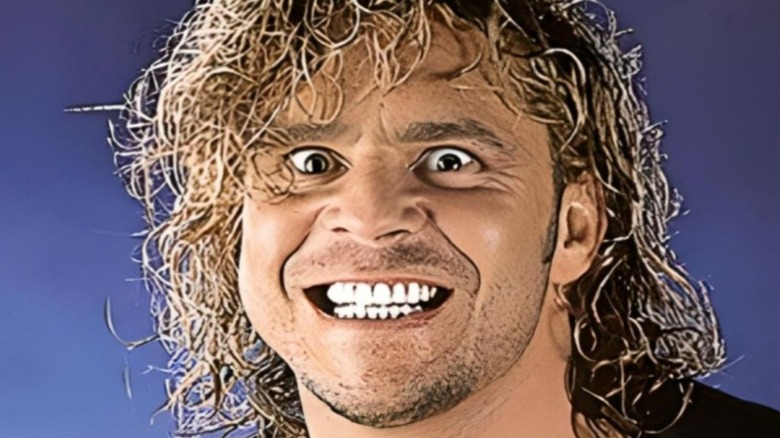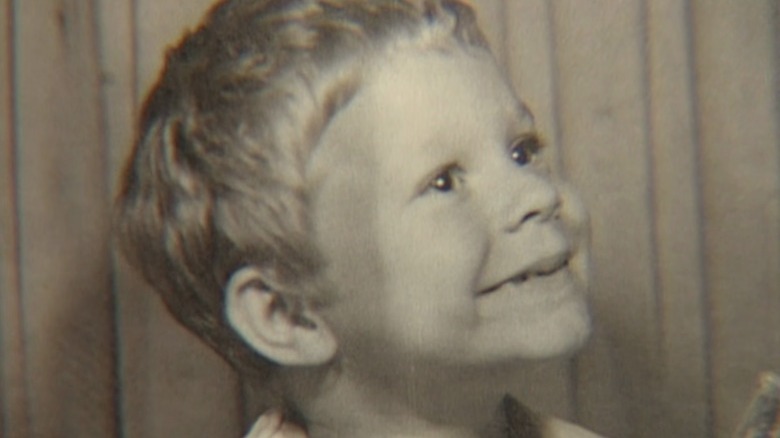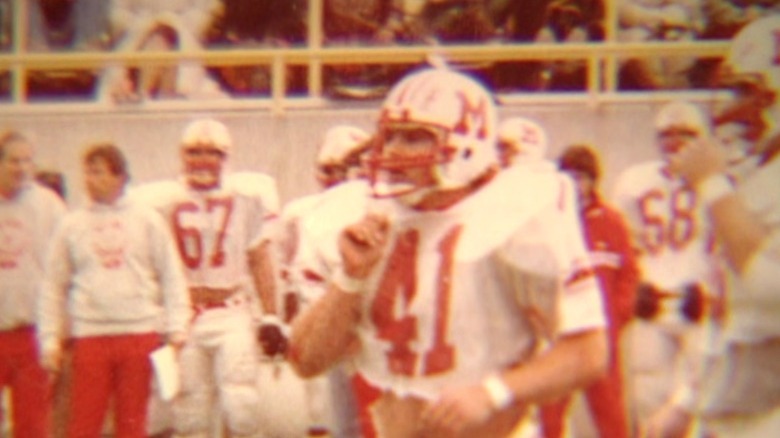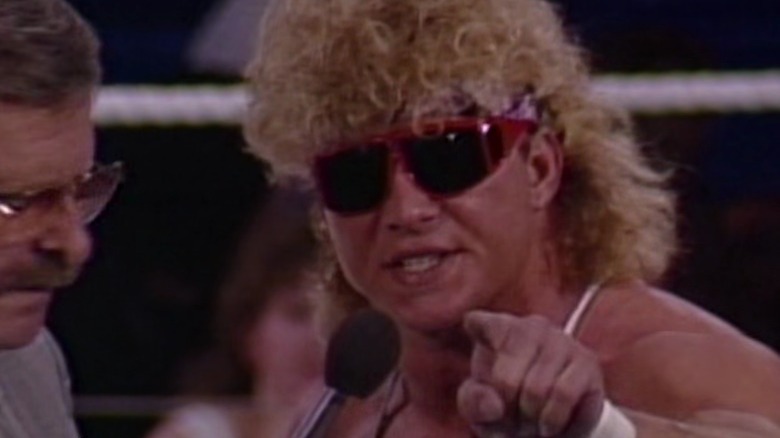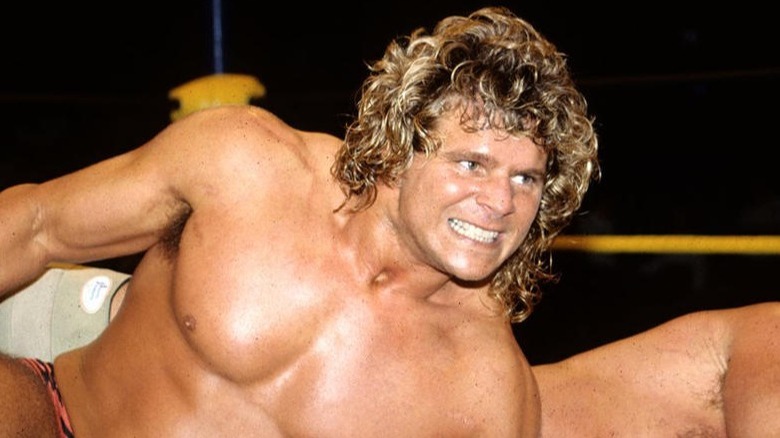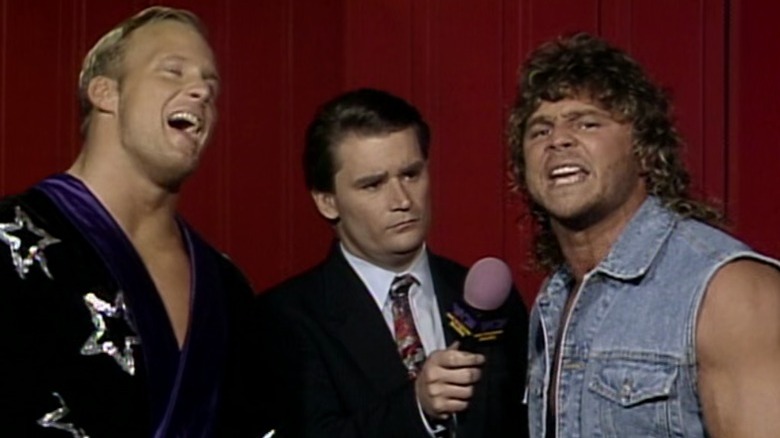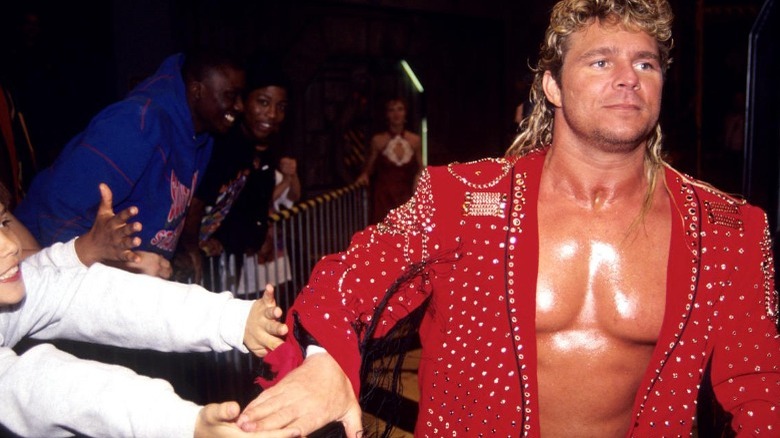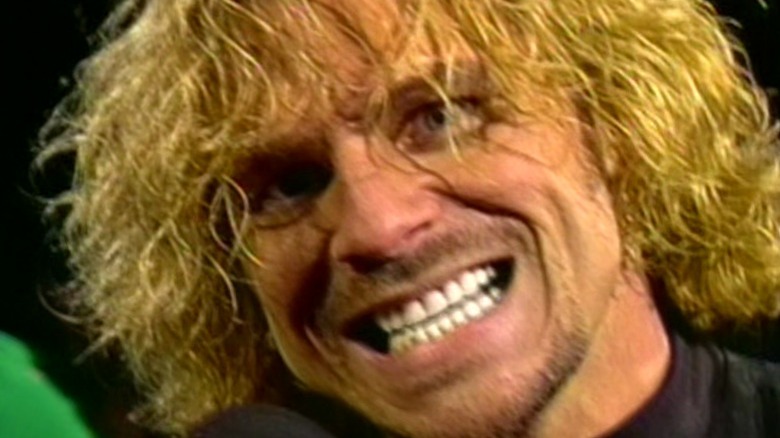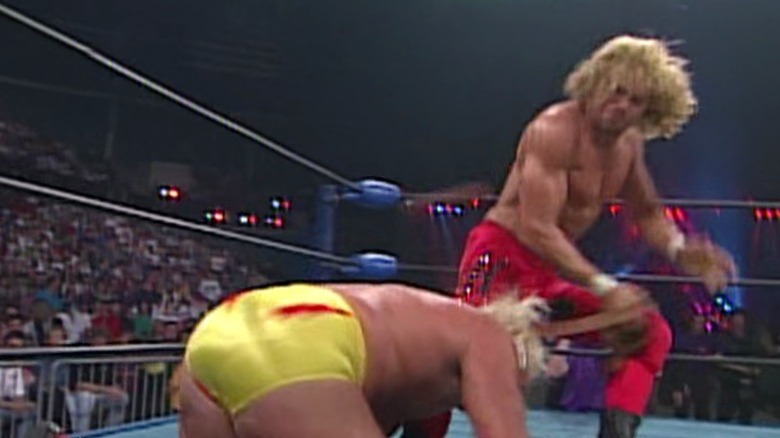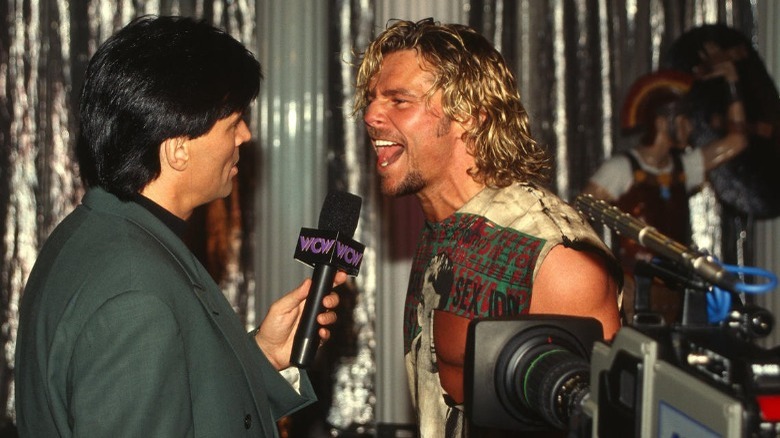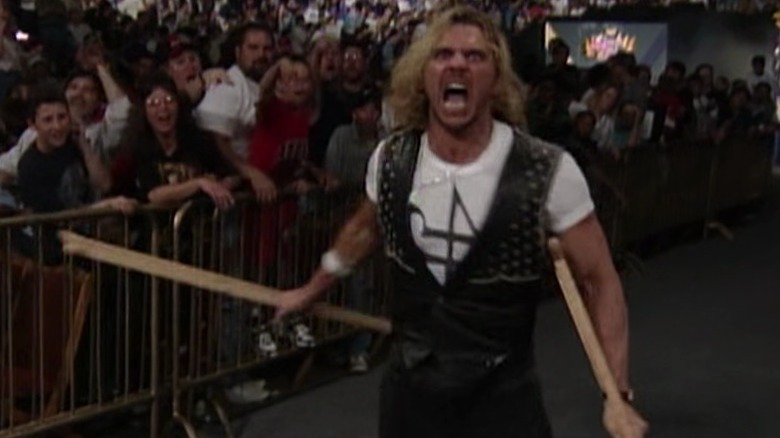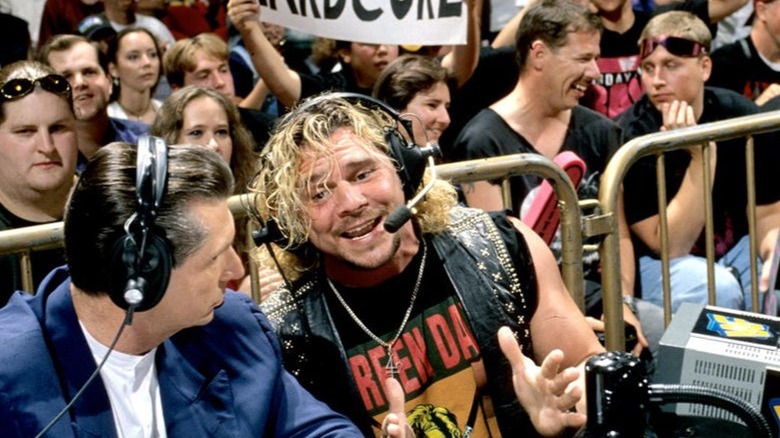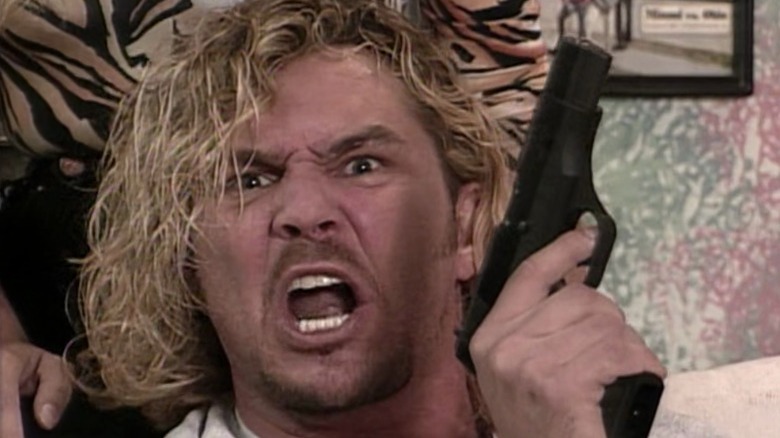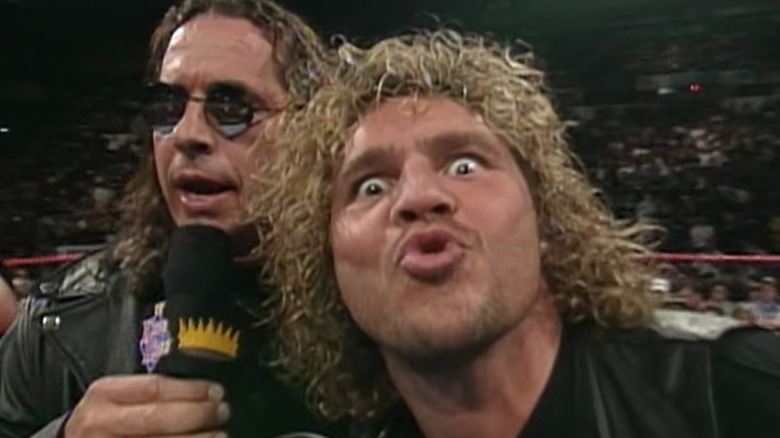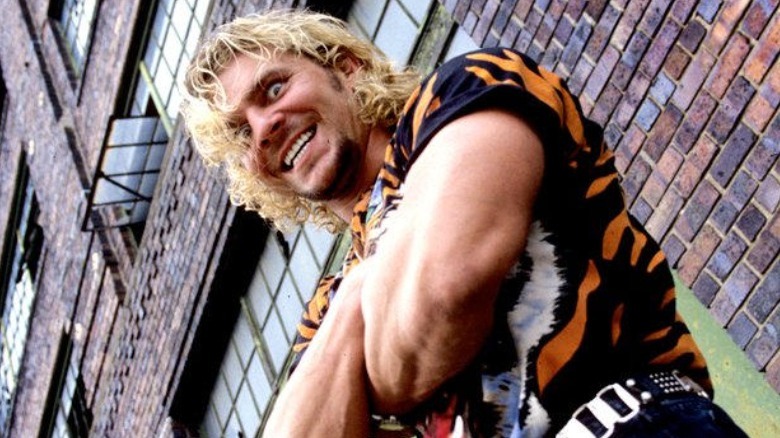The Tragic Life Of Brian Pillman
We may receive a commission on purchases made from links.
Brian Pillman was one of the most fascinating and controversial wrestlers of his generation. A great in-ring talent who was on the smaller side by the standards of his day, Pillman's matches with Jushin Liger were a hint of the cruiserweight revolution that would hit WCW a few years later. He would form one of the great underappreciated tag teams of his generation with friend and future legend Steve Austin. He'd get to be a part of two of the biggest stables of his era, having stints in both The Four Horsemen and The Hart Foundation.
But for every triumph in Pillman's life, there was a tragedy. Personal loss hit him both as a child and as an adult. He dealt with serious health problems from the very beginning and fought to return from injuries that would've retired others. He blurred the lines between reality and fiction like no one else, sparking a bidding war between WWF and WCW and getting even some who personally knew him to wonder who the real Pillman was. Dying before the age of 40, many still wonder just who the real Brian Pillman was. This is his story.
Brian Pillman's distinctive voice came from a medical condition
The long list of challenges Brian would face in life stated almost immediately. His father Howard died of a heart attack when Brian was only three months old. At the age of two, Brian developed polyps on his vocal cords. According to the Brian Pillman biography, "Crazy Like A Fox," the polyps at times threatened young Brian's life, cutting off his ability to breathe. During one episode, they caused his heart to stop three times in a single day, requiring a tracheotomy to save his life.
The polyps could be treated by being scraped away, but if they were not removed by the root, which was dangerous and difficult, they would soon grow back. As a result, Pillman would go through 31 surgeries by the age of five. The process of scraping Brian's vocal cords severely damaged them, requiring additional surgeries to restore his voice to a functional level. The end result was the gravelly vocal tone that became one of his most distinctive physical features. In an issue of Cincinnati Magazine, Pillman's mother said it caused him to be teased as a child and motivated him to learn to physically stand up for himself from an early age.
Against all odds, Pillman played in the NFL
Brian was a great athlete growing up, excelling at hockey and football. Being small for the latter, Pillman frequently had to fight against size biases despite putting in impressive results. He was the only person in 1979 to make the All-City team and not get a college scholarship offer. He went as a walk-on with Miami of Ohio and worked his way up the roster, earning awards like Mid American Conference Defensive Player of the Year and making an AP All-American Second Team. The player he was behind? William "Refrigerator" Perry. Yet just as before, he was the only person on that second team to not be drafted into the NFL.
That did not stop Pillman, who signed as a free agent with the Cincinnati Bengals and — against all expectations — earned a spot for them on special teams. The next year he tried out for the Buffalo Bills and was about to make the team, when according to the Wrestling Observer, an assistant coach found steroids in his room and as a result made him the final cut. Brian would go up north to the CFL to play for the Calgary Stampeders, but broke his ankle in just his third game with the team. His football career was over and he was going to need to find a new dream.
He learned to wrestle in the famous Hart family Dungeon
Pillman was not a huge pro wrestling fan growing up, but Kim Wood, the Bengals strength coach and something of a father figure to Brian, thought he'd be a natural at it. Wood loaned Pillman the money to train in one of the most famous wrestling schools in the world, the Hart Family Dungeon. Brian indeed took to wrestling quickly and was soon competing regularly for the Harts' local promotion, Stampede Wrestling. He formed a regular tag team with Bret Hart's brother Bruce, together known as Bad Company. In addition to Bruce, Pillman would find himself regularly working with Owen Hart, as well as future New Japan star Hiroshi Hase.
Brian's stint in Stampede ran nearly a full three years, from 1986 to 1988. He was voted Rookie of the Year by readers of the Wrestling Observer in 1987. But according to biographer Liam O'Rourke, Pillman's close relationships with members of the Hart family caused him to be viewed with jealousy by others on the Stampede roster. Tensions resulted in a locker room fight with wrestler Brick Bronsky, which Pillman won but suffered a torn tricep in the process. With Stampede stagnant, Brian took this as a sign he should start looking for a new home promotion.
His WCW run was full of ups, downs and historic moments
Reaching out to Jim Ross, Pillman was set to join WCW when a new booker, George Scott, was hired, a man who — according to "Crazy Like A Fox" – had no knowledge of Brian and zero interest in hiring him. Brian instead did a short stint in Japan. When Scott soon lost his job, Pillman was finally WCW bound. Throughout his WCW run, Pillman continued to be subject to WCW's revolving door of bookers and their opinions, some saw him as a future star while others had little interest in pushing him. As a result, Brian spent his entire WCW run in the undercard, always fighting for more.
There were highlights, though. A February 1990 match with Ric Flair on "WCW Saturday Night" holds the record for the highest rating that show ever drew. His match with Jushin Liger at Superbrawl II is seen as one of the great PPV openers of the era. In fact, the match gained such a reputation that when "WCW Nitro" debuted, a rematch between the two was the first bout to ever take place on the show.
The Hollywood Blonds brought Pillman and Steve Austin together
When Steve Austin initially got the proposal from WCW bookers to form a tag team with Brian, he resisted it. Austin had previously been slated for a possible singles push and saw being slotted into a tag team as a step-down. Eventually, Austin relented and the Hollywood Blonds were formed. Their chemistry in the ring was instant and their friendship out of the ring grew quickly as well. They immediately became a highlight of the promotion, and within months of forming had the tag team titles.
In fact, the Blonds had so much momentum, they were booked to be Ric Flair's opponent in his return match to the promotion. Arn Anderson and Flair vs. the Blonds headlined a Clash of the Champions special, Flair's first match for WCW in years. To the shock of many, it drew the lowest TV ratings in Clash history, 2.6 for the show overall. Despite the fact that the main event drew the highest ratings of any match on the show, a scapegoat was needed for the low overall numbers. As related by Jim Cornette on an episode of "Dark Side of the Ring," the Blonds were given the blame. They were disbanded shortly thereafter.
Pillman experienced more tragedy as an adult
Around this time Brian had married his first and only wife, Melanie. At the same time, he was in a bitter custody dispute over his daughter, Brittany. As it went on, Brittany's mother Rochelle disappeared. Fearing he himself would be viewed as a suspect, Brian went into the worst parts of Cincinnati in a frantic search, only to find himself arrested by the local police who thought they saw him swallow a pill. Brian plea-bargained down to drunk driving, and Rochelle was found safe weeks later.
Losing custody of her child, Rochelle wanted to die via suicide, and to do so while on the phone with Brian as an act of revenge. Unable to contact him, she died while talking to her mother instead. Pillman's friend Dave Meltzer said in a retrospective in the October 9th, 2006 edition of the Wrestling Observer that Brian was "devastated" by this act, and that this period was when things "started to change" when it came to Brian's mental state.
If you or anyone you know is having suicidal thoughts, please call the National Suicide Prevention Lifeline by dialing 988 or by calling 1-800-273-TALK (8255).
Pillman's Loose Cannon character fooled the wrestling world
Approaching his mid-thirties, low on the card, physically hurting, with his current contract soon coming up, Pillman devised a plan. He would create a character that was seen as crazy and unpredictable, who would even fool the wrestlers and media, that would make him the hottest free agent in wrestling. The Loose Cannon was born. Brian studied books and films about con artists, and also changed his look.
Convincing WCW head Eric Bischoff that they needed to fool everyone, the two worked together, along with booker Kevin Sullivan. Pillman would act wild and erratic both on air and behind the scenes, and Bischoff and Sullivan would act like they were legitimately mad. Stories would get planted in the wrestling newsletters that Pillman was on thin ice with the promotion, and even wrestlers backstage were convinced. As Kevin Sullivan revealed to Hannibal, Pillman went so far to play crazy that he proposed chaining himself to the goalposts during a Superbowl. Thankfully for his lawyers, he was talked out of that.
Brian created one of the most famous worked shoot angles of all time
The story around Pillman's new persona built to a match with Kevin Sullivan at Superbrawl. In the build-up, Sullivan broke a pencil during a promo, a sly insider reference that he was the booker (an insider term for the job is "the pencil"). The match at Superbrawl was to be a "Respect" Strap Match, the two men tied together, only ending when one said "I respect you" to the other. But on the night of the show, despite the backstage format sheet listing the match as being a planned 12 minutes, Pillman, just a minute in a half in, said "I respect you ... booker man" and voluntarily left the ring, flipping the audience off as he left.
Backstage, Pillman and Bischoff got into a shouting match before Brian left the building. A replacement match between Sullivan and Arn Anderson was hastily added. The whole thing had, in fact, been planned between Pillman, Bischoff, and Sullivan, but the talent and fans who witnessed it were kept out of the loop. Many believed they had just seen The Loose Cannon go into business for himself.
Brian Pillman fooled Eric Bischoff into giving him a real release
According to the Pillman biography, "Crazy Like A Fox," Pillman's plan to con the world even extended to Bischoff himself. The two were doing an angle where Bischoff had "fired" Brian and Pillman convinced Bischoff that, to really make everyone think that it was real, WCW's legal team needed to write a legitimate release for Pillman. Bischoff agreed, and even though Brian's contract was set to expire in three weeks anyway, Pillman was now free to negotiate with both WCW and WWF — even as his angle with WCW was in progress — and was no longer beholden to the orders of the company.
During this period, Pillman even made some appearances in ECW, acting as if he was truly on the outs with WCW and running down management. He began a feud with Shane Douglas that never turned into a match. He also shot some very memorable skits, including one where he fought a giant pencil. Most infamously, he threatened to urinate in the middle of ECW Arena, until ECW booker Paul Heyman stopped him.
A severe car accident changed Brian Pillman's career and life
The Loose Cannon character had accomplished its goal of making Pillman a hot free agent. He had an offer from WCW for $425,000 a year for three years and he had an offer from WWF for somewhere between $250,000 and $400,000 a year for three years. Then came another tragedy, when Brian crashed his newly purchased Humvee. The accident sent Pillman through the roof, high into the air. Bones in his face were so badly broken that he was unrecognizable. His ankle was destroyed to the point where bone was needed from his hip to reconstruct it.
Brian had always wanted to stay in WCW over WWF, and they were offering more money. But WWF's money was guaranteed, a perk reserved for few in the company at this time. Meanwhile, WCW's new contract allowed them a chance to cut Brian every 90 days. With doctors telling him he may never be able to even run again, let alone wrestle, Pillman wanted job security. Pillman changed plans and signed the guaranteed deal with WWF.
Pillman returned to action far too soon
Even though Brian was just injured, he was eager to prove his worth to WWF, appearing on TV for them in non-wrestling segments. At one point, while getting intravenous antibiotics for a severe infection, Pillman went as far as to unhook himself from the IV, travel to do the event, and then hooked himself back up when he got home. Eventually, doctors informed him that due to his schedule causing him to put weight on his healing ankle when he shouldn't have, it was not healing properly and would need to be rebroken. Pillman's in-ring debut was delayed further.
When Brian finally did wrestle in the WWF, he was a shadow of his former self. His most recent ankle surgery required fusing it into one position, severely reducing his mobility. Formerly an athletic high flyer, Brian now found himself having to rely on bells and whistles and shortcuts to try to entertain the fans, rather than his trademark athleticism.
Brian Pillman and Steve Austin did a controversial gun angle
During Pillman's recovery, he engaged in an infamous storyline with former tag partner Steve Austin, now the hottest rising star in the WWF. During one "Raw," Austin attacked Brian, threading his injured ankle through a chair and stomping on it. To this day, this act in wrestling is known as "Pillmanizing." The storyline didn't stop there, building to another "Raw" where cameras were with Pillman at his home as he prepared for an attack on the premises from a furious Austin. Brain pulled out a gun and ended the segment by pointing it at Steve as he was held back.
The angle pushed boundaries for the era and was the talk of the industry. The ratings it drew, though, were middling at best. Brian and Steve had hoped the segment would lead Raw to finally break Nitro's streak of ratings dominance, but it failed to do so. Meanwhile, USA Network — home of "Raw" — issued a public apology for both the use of the gun and Pillman uttering profanity during the segment. The likes of it would not be seen again on WWF TV.
The Hart Foundation was a late-career highlight for Pillman
Once back in the ring with WWF, Pillman found himself lucky enough to be pulled into one of the hottest feuds in the promotion. Bret Hart was turning heel and reforming the Hart Foundation, and Pillman was soon enlisted as a member. It was a perfect fit, both due to Pillman's history with Steve Austin, who the Foundation was feuding with, as well as his legitimate close ties to the Hart family. Pillman became the only member of the Hart Foundation not related to the Hart family by blood or marriage.
Although initially having some misgivings about Bret's choice to remain a face in Canada while a heel in America, Pillman was soon happily proven wrong. One of the famous high points of the feud was WWF's Canadian Stampede PPV, a show that main evented with a ten-man tag Brian participated in. Considered a classic show with an electric atmosphere, Pillman considered that match the high point of his career. Dave Meltzer recounted in that October 9h, 2006 Observer edition that after the show Brian called him and told him as such, saying "nothing he had ever done in the business, the matches with Liger or Flair, the turning on Sting, compared to that night."
Pillman died far too soon
Unfortunately, as was the pattern of Brian's life, the good times never lasted too long. He eventually transitioned to a feud with Goldust over his valet Marlena, a former girlfriend of Pillman's and Goldust's real-life wife. When Pillman did not arrive at the building on time for a PPV match between the two, people began to worry. Brian was found in his hotel room, dead of a massive heart attack. He was only 35.
Brian left behind a wife and five children. One of them, Brian Pillman Jr., competes today in AEW. He also leaves behind a legacy of great performances and incredible talent, but also wasted potential. Pillman worked hard to fight against football and pro wrestling's size biases and a history of health problems but still left us with so much unfulfilled potential. He created an amazing tag team that never got a fair shot, he ingenuously sparked a bidding war over his services, and never got the dream run he thought would be the end result of that. Despite all the challenges, Brian packed a lot of wild stories into those short 35 years.
